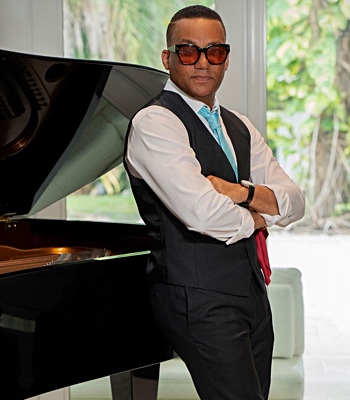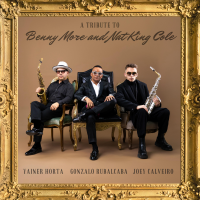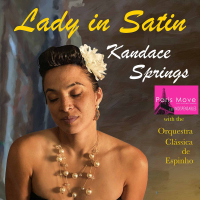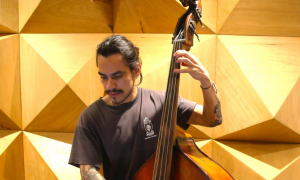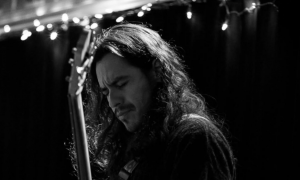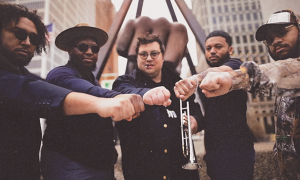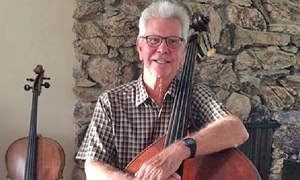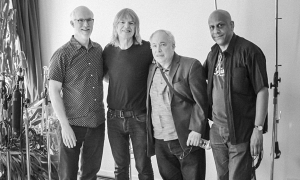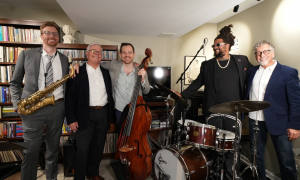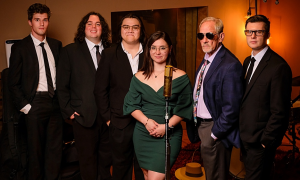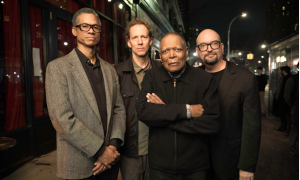
Ahmad Jamal, whose spare but highly melodic piano style on trio recordings beginning in 1951 transformed the sound of the jazz piano and deeply influenced Miles Davis and Red Garland, died on April 16. He was 92.
At the dawn of the 1950s, Jamal's gleeful and relaxed style was a radical departure from other piano approaches at the time, when thick chords and a strong left hand held sway on the jazz piano. While critics would scoff at Jamal's recordings and live performances later in the 1950s for sounding lounge-y and commercial, trumpeter Miles Davis knew better and was deeply inspired by the pianist's swinging melodic approach and respect for space. So was Davis's pianist, Red Garland.
As I wrote in my Wall Street Journal essay on Jamal's wildly successful 1958 album But Not for Me, recorded live at Chicago's Pershing Lounge...
Mr. Jamal's distinctive style—melodies played on the piano's upper-most notes combined with elegant and brief mid-keyboard chord clusters—had been revered by jazz musicians since his first recordings in 1951. Miles Davis so admired Mr. Jamal's lyrical, space-rich approach on “Surrey With the Fringe on Top," “A Gal in Calico," “Billy Boy" and other early recordings by the pianist that he recorded them virtually the same way. The trio's conversational approach also left a lasting impression on many pianists, including Oscar Peterson, Red Garland, Bill Evans, Phineas Newborn Jr. and Herbie Hancock.
In an unpublished interview with Ahmad, I asked him how he felt about Davis's and Garland's recordings. My suspicion had been that Davis asked Ahmad to join his group and when Ahmad declined, Davis had his new pianist, Garland, knock off Ahmad's sound. According to Ahmad, that wasn't the case:
Marc Myers: Did Miles Davis ask you to join his group in the early 50s, after he signed with Prestige?
Ahmad Jamal: Miles used to come into the Pershing in Chicago whenever he could to hear us. We were both in leadership roles. It wasn’t proper for him to ask me to join his group or me to ask him to join mine. I’ve been leading a trio since 1951. I was busy with my groups and he was busy with his.
MM: How did you feel when you heard Red Garland, at the direction of Davis, record Billy Boy almost identically to yours?
AJ: It was great. Thirty seconds of it was in Who's Afraid of Virginia Woolf on Broadway in 2005 for two years, so I got royalties. When it’s public domain, like Billy Boy, I could copyright the arrangement. But I couldn’t copyright Poinciana, since it wasn’t in the public domain.
Ahmad went on to tell me that his approach with his right hand had much in common with the movement of felines. “I love cats," Ahmad said. “I used to raise cats when I was a kid. I can’t do it now because I’ve developed an allergic to them."
The popularity and sales of Jamal's recordings were extraordinary, starting with Ahmad Jamal's Three Strings, The Piano Scene and Ahmad Jamal Plays (1951-1955). Again, from my WSJ essay...
Recorded on Jan. 16, 1958, and released that spring, “But Not for Me" deeply affected how jazz pianists voiced standards and interacted musically with their bass players and drummers. By August, the album had sold nearly 48,000 copies—a staggering accomplishment since any album's sale of just 20,000 copies in its first few months back then was considered significant. Equally impressive was that the album was on Argo—a niche label based in Chicago. By contrast, one of jazz's most successful albums—the Dave Brubeck Quartet's “Time Out"—wouldn't be released until the following year and was greatly helped by Columbia's powerful mail-order record club and marketing machine. By the end of 1958, “But Not for Me" was the top-selling jazz album in stores.
By the late 1960s, Ahmad's style had changed, becoming more percussive and heavier, much to the disappointment of his earlier fans. Ahmad didn't waver, though, and only recently began to revive his former popular style.
Here are 10 of my favorite Ahmad Jamal clips...
Here's Darn That Dream with Israel Crosby (bass) and Vernell Fournier (drums) in 1960 on Jazz From Sixty-One, a CBS TV show taped at the network's Studio 61, located in the former Monroe Theater at 1456 First Avenue. For those not in the know, the awe-struck people standing around the piano are jazz giants: From left, pianist Hank Jones, trumpeter Buck Clayton, bassist George Duvivier in dark glasses, tenor saxophonist Ben Webster in a hat, trombonist Vic Dickenson is back there, as is jazz author and critic Nat Hentoff with the pipe and his then wife, and drummer Jo Jones is next to him...
Here's The Surrey With the Fringe on Top in 1951...
Here's Will You Still Be Mine in 1951...
Here's New Rhumba in 1955...
Here's On Green Dolphin Street in 1956 (compare the mood and elegance to the version by the Miles Davis Sextet in May 1958)...
Here's But Not for Me, from At the Pershing in 1958...
Here's It's You or No One from At the Pershing Vol. 2...
Here's Time on My Hands in 1960...
Here's Two Different Worlds in 1962...
Here's I Didn't Know What Time It Was, from the glorious recent releases by Jazz Detective Records...
Bonus: Here's Ahmad in 1971 in France...
MM: How did you feel when you heard Red Garland, at the direction of Davis, record Billy Boy almost identically to yours?
AJ: It was great. Thirty seconds of it was in Who's Afraid of Virginia Woolf on Broadway in 2005 for two years, so I got royalties. When it’s public domain, like Billy Boy, I could copyright the arrangement. But I couldn’t copyright Poinciana, since it wasn’t in the public domain.
Ahmad went on to tell me that his approach with his right hand had much in common with the movement of felines. “I love cats," Ahmad said. “I used to raise cats when I was a kid. I can’t do it now because I’ve developed an allergic to them."
The popularity and sales of Jamal's recordings were extraordinary, starting with Ahmad Jamal's Three Strings, The Piano Scene and Ahmad Jamal Plays (1951-1955). Again, from my WSJ essay...
Recorded on Jan. 16, 1958, and released that spring, “But Not for Me" deeply affected how jazz pianists voiced standards and interacted musically with their bass players and drummers. By August, the album had sold nearly 48,000 copies—a staggering accomplishment since any album's sale of just 20,000 copies in its first few months back then was considered significant. Equally impressive was that the album was on Argo—a niche label based in Chicago. By contrast, one of jazz's most successful albums—the Dave Brubeck Quartet's “Time Out"—wouldn't be released until the following year and was greatly helped by Columbia's powerful mail-order record club and marketing machine. By the end of 1958, “But Not for Me" was the top-selling jazz album in stores.
By the late 1960s, Ahmad's style had changed, becoming more percussive and heavier, much to the disappointment of his earlier fans. Ahmad didn't waver, though, and only recently began to revive his former popular style.
Here are 10 of my favorite Ahmad Jamal clips...
Here's Darn That Dream with Israel Crosby (bass) and Vernell Fournier (drums) in 1960 on Jazz From Sixty-One, a CBS TV show taped at the network's Studio 61, located in the former Monroe Theater at 1456 First Avenue. For those not in the know, the awe-struck people standing around the piano are jazz giants: From left, pianist Hank Jones, trumpeter Buck Clayton, bassist George Duvivier in dark glasses, tenor saxophonist Ben Webster in a hat, trombonist Vic Dickenson is back there, as is jazz author and critic Nat Hentoff with the pipe and his then wife, and drummer Jo Jones is next to him...
Here's The Surrey With the Fringe on Top in 1951...
Here's Will You Still Be Mine in 1951...
Here's New Rhumba in 1955...
Here's On Green Dolphin Street in 1956 (compare the mood and elegance to the version by the Miles Davis Sextet in May 1958)...
Here's But Not for Me, from At the Pershing in 1958...
Here's It's You or No One from At the Pershing Vol. 2...
Here's Time on My Hands in 1960...
Here's Two Different Worlds in 1962...
Here's I Didn't Know What Time It Was, from the glorious recent releases by Jazz Detective Records...
Bonus: Here's Ahmad in 1971 in France...
At the dawn of the 1950s, Jamal's gleeful and relaxed style was a radical departure from other piano approaches at the time, when thick chords and a strong left hand held sway on the jazz piano. While critics would scoff at Jamal's recordings and live performances later in the 1950s for sounding lounge-y and commercial, trumpeter Miles Davis knew better and was deeply inspired by the pianist's swinging melodic approach and respect for space. So was Davis's pianist, Red Garland.
As I wrote in my Wall Street Journal essay on Jamal's wildly successful 1958 album But Not for Me, recorded live at Chicago's Pershing Lounge...
Mr. Jamal's distinctive style—melodies played on the piano's upper-most notes combined with elegant and brief mid-keyboard chord clusters—had been revered by jazz musicians since his first recordings in 1951. Miles Davis so admired Mr. Jamal's lyrical, space-rich approach on “Surrey With the Fringe on Top," “A Gal in Calico," “Billy Boy" and other early recordings by the pianist that he recorded them virtually the same way. The trio's conversational approach also left a lasting impression on many pianists, including Oscar Peterson, Red Garland, Bill Evans, Phineas Newborn Jr. and Herbie Hancock.
In an unpublished interview with Ahmad, I asked him how he felt about Davis's and Garland's recordings. My suspicion had been that Davis asked Ahmad to join his group and when Ahmad declined, Davis had his new pianist, Garland, knock off Ahmad's sound. According to Ahmad, that wasn't the case:
Marc Myers: Did Miles Davis ask you to join his group in the early 50s, after he signed with Prestige?
Ahmad Jamal: Miles used to come into the Pershing in Chicago whenever he could to hear us. We were both in leadership roles. It wasn’t proper for him to ask me to join his group or me to ask him to join mine. I’ve been leading a trio since 1951. I was busy with my groups and he was busy with his.
MM: How did you feel when you heard Red Garland, at the direction of Davis, record Billy Boy almost identically to yours?
AJ: It was great. Thirty seconds of it was in Who's Afraid of Virginia Woolf on Broadway in 2005 for two years, so I got royalties. When it’s public domain, like Billy Boy, I could copyright the arrangement. But I couldn’t copyright Poinciana, since it wasn’t in the public domain.
Ahmad went on to tell me that his approach with his right hand had much in common with the movement of felines. “I love cats," Ahmad said. “I used to raise cats when I was a kid. I can’t do it now because I’ve developed an allergic to them."
The popularity and sales of Jamal's recordings were extraordinary, starting with Ahmad Jamal's Three Strings, The Piano Scene and Ahmad Jamal Plays (1951-1955). Again, from my WSJ essay...
Recorded on Jan. 16, 1958, and released that spring, “But Not for Me" deeply affected how jazz pianists voiced standards and interacted musically with their bass players and drummers. By August, the album had sold nearly 48,000 copies—a staggering accomplishment since any album's sale of just 20,000 copies in its first few months back then was considered significant. Equally impressive was that the album was on Argo—a niche label based in Chicago. By contrast, one of jazz's most successful albums—the Dave Brubeck Quartet's “Time Out"—wouldn't be released until the following year and was greatly helped by Columbia's powerful mail-order record club and marketing machine. By the end of 1958, “But Not for Me" was the top-selling jazz album in stores.
By the late 1960s, Ahmad's style had changed, becoming more percussive and heavier, much to the disappointment of his earlier fans. Ahmad didn't waver, though, and only recently began to revive his former popular style.
Here are 10 of my favorite Ahmad Jamal clips...
Here's Darn That Dream with Israel Crosby (bass) and Vernell Fournier (drums) in 1960 on Jazz From Sixty-One, a CBS TV show taped at the network's Studio 61, located in the former Monroe Theater at 1456 First Avenue. For those not in the know, the awe-struck people standing around the piano are jazz giants: From left, pianist Hank Jones, trumpeter Buck Clayton, bassist George Duvivier in dark glasses, tenor saxophonist Ben Webster in a hat, trombonist Vic Dickenson is back there, as is jazz author and critic Nat Hentoff with the pipe and his then wife, and drummer Jo Jones is next to him...
Here's The Surrey With the Fringe on Top in 1951...
Here's Will You Still Be Mine in 1951...
Here's New Rhumba in 1955...
Here's On Green Dolphin Street in 1956 (compare the mood and elegance to the version by the Miles Davis Sextet in May 1958)...
Here's But Not for Me, from At the Pershing in 1958...
Here's It's You or No One from At the Pershing Vol. 2...
Here's Time on My Hands in 1960...
Here's Two Different Worlds in 1962...
Here's I Didn't Know What Time It Was, from the glorious recent releases by Jazz Detective Records...
Bonus: Here's Ahmad in 1971 in France...
MM: How did you feel when you heard Red Garland, at the direction of Davis, record Billy Boy almost identically to yours?
AJ: It was great. Thirty seconds of it was in Who's Afraid of Virginia Woolf on Broadway in 2005 for two years, so I got royalties. When it’s public domain, like Billy Boy, I could copyright the arrangement. But I couldn’t copyright Poinciana, since it wasn’t in the public domain.
Ahmad went on to tell me that his approach with his right hand had much in common with the movement of felines. “I love cats," Ahmad said. “I used to raise cats when I was a kid. I can’t do it now because I’ve developed an allergic to them."
The popularity and sales of Jamal's recordings were extraordinary, starting with Ahmad Jamal's Three Strings, The Piano Scene and Ahmad Jamal Plays (1951-1955). Again, from my WSJ essay...
Recorded on Jan. 16, 1958, and released that spring, “But Not for Me" deeply affected how jazz pianists voiced standards and interacted musically with their bass players and drummers. By August, the album had sold nearly 48,000 copies—a staggering accomplishment since any album's sale of just 20,000 copies in its first few months back then was considered significant. Equally impressive was that the album was on Argo—a niche label based in Chicago. By contrast, one of jazz's most successful albums—the Dave Brubeck Quartet's “Time Out"—wouldn't be released until the following year and was greatly helped by Columbia's powerful mail-order record club and marketing machine. By the end of 1958, “But Not for Me" was the top-selling jazz album in stores.
By the late 1960s, Ahmad's style had changed, becoming more percussive and heavier, much to the disappointment of his earlier fans. Ahmad didn't waver, though, and only recently began to revive his former popular style.
Here are 10 of my favorite Ahmad Jamal clips...
Here's Darn That Dream with Israel Crosby (bass) and Vernell Fournier (drums) in 1960 on Jazz From Sixty-One, a CBS TV show taped at the network's Studio 61, located in the former Monroe Theater at 1456 First Avenue. For those not in the know, the awe-struck people standing around the piano are jazz giants: From left, pianist Hank Jones, trumpeter Buck Clayton, bassist George Duvivier in dark glasses, tenor saxophonist Ben Webster in a hat, trombonist Vic Dickenson is back there, as is jazz author and critic Nat Hentoff with the pipe and his then wife, and drummer Jo Jones is next to him...
Here's The Surrey With the Fringe on Top in 1951...
Here's Will You Still Be Mine in 1951...
Here's New Rhumba in 1955...
Here's On Green Dolphin Street in 1956 (compare the mood and elegance to the version by the Miles Davis Sextet in May 1958)...
Here's But Not for Me, from At the Pershing in 1958...
Here's It's You or No One from At the Pershing Vol. 2...
Here's Time on My Hands in 1960...
Here's Two Different Worlds in 1962...
Here's I Didn't Know What Time It Was, from the glorious recent releases by Jazz Detective Records...
Bonus: Here's Ahmad in 1971 in France...
This story appears courtesy of JazzWax by Marc Myers.
Copyright © 2025. All rights reserved.



